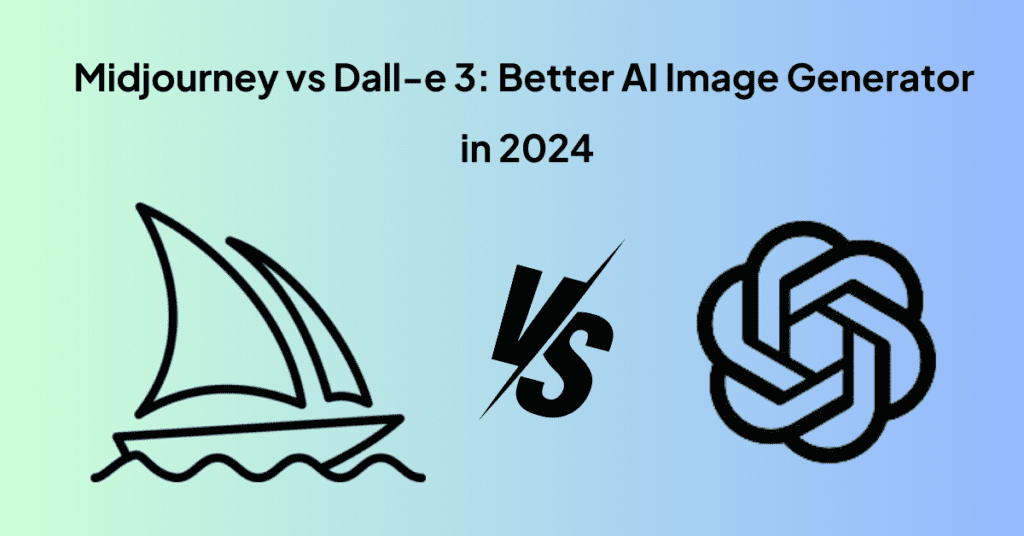In 2024, the AI art scene is buzzing with excitement as two leading AI tools, Midjourney and Dall-e 3, go head-to-head in the era of artificial intelligence and AI image generation. Both platforms (Midjourney vs Dall-e 3) leverage cutting-edge AI technologies to transform simple prompts into mesmerizing AI art.
Whether you use Midjourney or engage with OpenAI’s Dalle 3, you’re tapping into powerful diffusion techniques that bring your creative visions to life. These AI art generators are not just tools; they’re gateways to limitless creativity, where every user—from artists to hobbyists—can create stunning visuals.
With the added assistance of AI models like ChatGPT, navigating and maximizing the potential of these platforms has never been easier. Explore the future of digital creativity with these revolutionary image-generation platforms to generate images.
Here’s an AI image generation by DALL·E 3: “A watercolor portrayal of a Victorian lady traversing an enchanted garden on a unicorn, surrounded by blooming cherry blossoms.”
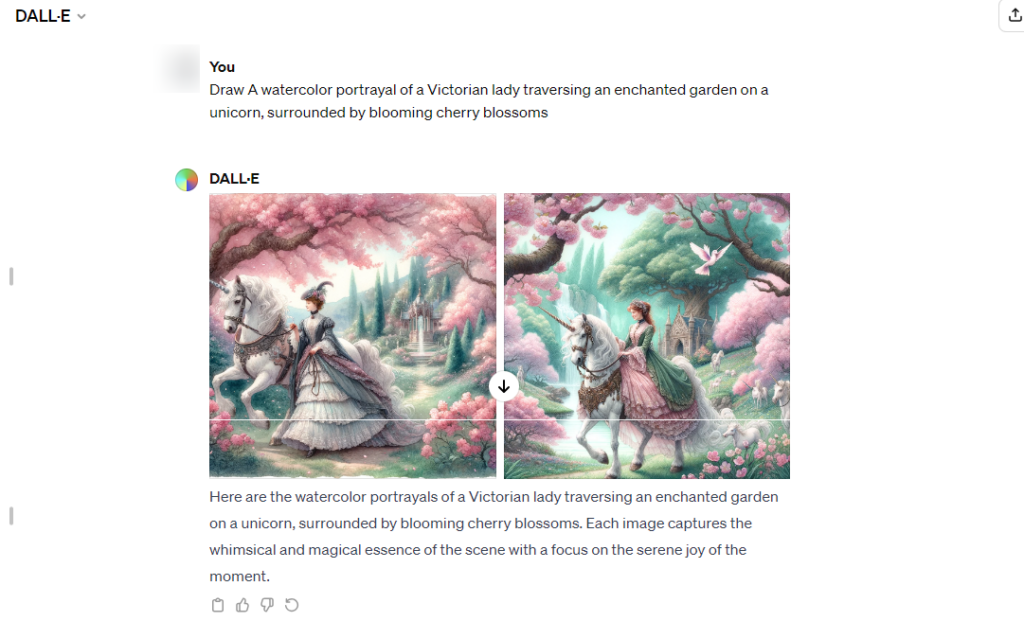

And here’s Midjourney’s


Comparing Midjourney vs Dall-e 3, you can see that Dall-e has done a tremendous job creating a watercolor portrayal. Meanwhile, Midjourney’s output is closer to realistic watercolor portrayal.
However, it’s not the final verdict. Let’s dive into more details for better image comparison.
DALL·E 3 and Midjourney: How Do They Work?
In the evolving landscape of generative AI, two standout tools have captured the imagination of creators and innovators alike: DALL·E 3 by OpenAI and Midjourney, created by the namesake team, Midjourney. These platforms are at the forefront of AI-driven image generation, allowing users to turn textual prompts into high-quality visual art.
Here’s a breakdown of how these two technologies operate, highlighting their unique features and applications.
How They Work: The Basics
- Training on Text-Image Pairs: DALL·E 3 and Midjourney have been meticulously trained on extensive datasets comprising millions, if not billions, of text-image pairs. This comprehensive training enables them to understand and generate images based on various concepts and descriptions, from the simple to the complex.
- Diffusion Process for Image Creation: At the heart of their image generation capabilities is a process known as Diffusion. This involves starting with a random field of noise and iteratively refining it to match the intended output more closely, as described by the user’s prompt. The inherent randomness in the initial stages ensures that the generated images can vary significantly even with identical prompts, adding a unique touch to every creation.
Key Features and Differentiators
OpenAI’s DALL·E 3:
- Generative AI Excellence: OpenAI’s DALL·E 3 excels in translating intricate prompts into detailed images, showcasing a remarkable ability in prompt engineering. This makes it particularly adept for use cases requiring precise adherence to complex conceptual descriptions.
- Image Quality and Diversity: With an emphasis on producing high-quality visuals, DALL·E 3 is designed to cater to a broad spectrum of artistic and practical applications, from digital art to marketing materials.
Midjourney:
- Community and Collaboration: Unique to Midjourney is its integration with Discord, facilitating a community-driven approach to AI art creation. This platform encourages sharing, collaboration, and feedback, enriching the creative process.
- Use Case Versatility: Created by Midjourney with a focus on diversity, this tool is tailored for a wide range of applications, from artistic expression to conceptual visualization, demonstrating its flexibility across various domains.
While DALL·E 3 and Midjourney leverage generative AI to generate images from textual prompts, their distinct methodologies, data training, and platform philosophies result in different strengths and use cases. DALL·E 3 is highly regarded for its ability to produce high-quality images that closely match specific prompts, a testament to its advanced prompt engineering capabilities.
Conversely, Midjourney, with its vital community aspect through Discord, offers a more collaborative environment, allowing for broader experimentation and exploration within image generation.
Choosing between DALL·E 3 and Midjourney ultimately boils down to the specific requirements of the project at hand, whether it prioritizes image quality, the specificity of the generated content, or the collaborative nature of the creative process. Both platforms offer unique advantages, making them invaluable tools in AI-generated imagery for 2024 and beyond.
Midjourney vs Dall-e 3 At a Glance
DALL·E 3 and Midjourney both serve similar purposes, yet they exhibit notable differences.
Here is a brief overview of the key differences, with a more comprehensive analysis to follow.
Features of Dall-E 3
Dall-E 3, a progression in AI-driven art creation, enhances the capabilities for generating images with more precision and variety. It’s available for ChatGPT Plus users at $20/month, offering improved features over its predecessor, Dall-E 2. Notable enhancements include:
- Aspect Ratios and Sizes: Offers flexibility with three image sizes (1024×1024, 1792×1024, 1024×1792) for various creative outputs.
- Enhanced Styles and Quality: Introduces ‘natural’ and ‘vivid’ styles and ‘standard’ and ‘HD’ quality options, providing finer detail and consistency in images.
- Prompt Rewriting with GPT-4: Utilizes GPT-4 for optimizing prompts, ensuring more accurate and detailed image generation.
These features mark Dall-E 3 as a significant advancement in AI image generation, offering creators, marketers, and educators versatile tools for their projects.
Dall-E 3 Pros and Cons
Dall-E 3, the latest advancement in AI tools for image generation, represents a significant leap forward in creative and practical applications. By transforming text prompts into visual representations, this technology opens new horizons for designers, marketers, and content creators. However, like any technological innovation, it has pros and cons.
Pros
- Enhanced Creativity: Dall-E 3 allows users to generate an image from virtually any description, pushing the boundaries of imagination and creativity.
- Efficiency: It significantly reduces the time and effort required to bring visual concepts to life, offering different results in seconds.
- Accessibility: This tool democratizes design, making high-quality visual content accessible to non-professionals.
Cons
- Quality Variability: The quality of Dall-E 3 images can vary, with some outputs requiring refinement to meet professional standards.
- Ethical Concerns: The technology raises questions about copyright and the originality of content, complicating the legal landscape for creators.
- Dependency: Over Reliance on AI tools might stifle individual creativity and skill development in traditional art and design techniques.
Dall-E 3, while groundbreaking, presents a complex mix of opportunities and challenges that users must navigate to harness its full potential.
Features of Midjourney
Midjourney, a cutting-edge text-to-image AI, generates aesthetically pleasing images emphasizing artistry and visual appeal. Unlike traditional web applications, Midjourney operates through a Discord bot, offering a unique and interactive platform for creative image generation.
- Creative Image Generation: Specializes in creating images that are painterly and visually appealing by default, focusing on elements like complementary colors, light and shadow, and detailed composition.
- Discord Bot Integration: Midjourney V6 is accessible through a Discord bot, making it a user-friendly platform for generating images without coding or a web application.
- Interactive Experience: Users can see live prompts and images created by others in the Midjourney Discord, enhancing the community aspect of creative exploration.
- High-Quality Outputs: The images created by Midjourney boast sharp details and a photorealistic quality that rivals traditional photography, yet with an artistic twist that sets them apart.
- Versatile Image Types: From photorealistic scenes to 2D art, painting, illustrations, and even 3D visual art mockups, Midjourney’s capabilities are extensive and diverse, catering to a wide range of creative needs.
Midjourney Pros and Cons
Midjourney, a leading figure in artificial intelligence for image generation, offers innovative solutions alongside unique challenges. Its strengths and weaknesses become evident as we explore its features and limitations.
Pros
- Innovative AI Model: Revolutionizes digital image generation with photorealistic outputs.
- User-Friendly: Designed for accessibility, appealing to a broad audience.
- Versatile Applications: Suitable for designers, marketers, and content creators across various industries.
Cons
- Poor Usability: Operates exclusively through Discord, complicating the onboarding process and compromising user privacy.
- Highly Censored: Strict content rules limit creative freedom, affecting the diversity of generated images.
- Limited Understanding of Context: Struggles with specialized domains or industries, focusing more on aesthetics than accuracy.
- Lack of Creativity: Need to conceptualize beyond real-world data, impacting its use in creative industries.
- Costly: No longer offers a free trial, with monthly pricing plans ranging from $10 to $120.
Compared to DALL-E 2, Midjourney stands out for its photorealistic images but faces usability, censorship, and creativity challenges. Both tools allow users to prompt and generate images, yet their distinct features cater to different user needs and preferences.
Hence, while Midjourney shines in creating realistic images, its limitations highlight areas for potential growth and improvement within the AI image generation landscape.
Comparing Midjourney vs Dall-e 3
Embarking on an in-depth comparison between Midjourney and DALL-E reveals a captivating exploration into the era of AI-driven creativity. As we delve into this analysis, it’s crucial to consider how each platform caters to specific requirements and preferences, offering unique advantages.
Whether you aim to master Midjourney’s nuanced capabilities or harness the diverse imagery generated by DALL-E, understanding their distinct features will illuminate the path to choosing the right tool for your creative endeavors.
Dall-E is Simpler to Use
DALL·E 3 can be used via ChatGPT, the Bing Image Creator, Microsoft Paint, and other platforms via its API. They all provide a similar user experience, but ChatGPT is considered the best and easiest to use, so I’ll mainly discuss it in this comparison. However, to use it on ChatGPT, you must be a ChatGPT Plus member. If you’re not, you might want to explore the other options available for free.
Although several methods exist to use DALL·E 3, they all operate similarly straightforwardly: you request DALL·E 3 to generate an image.
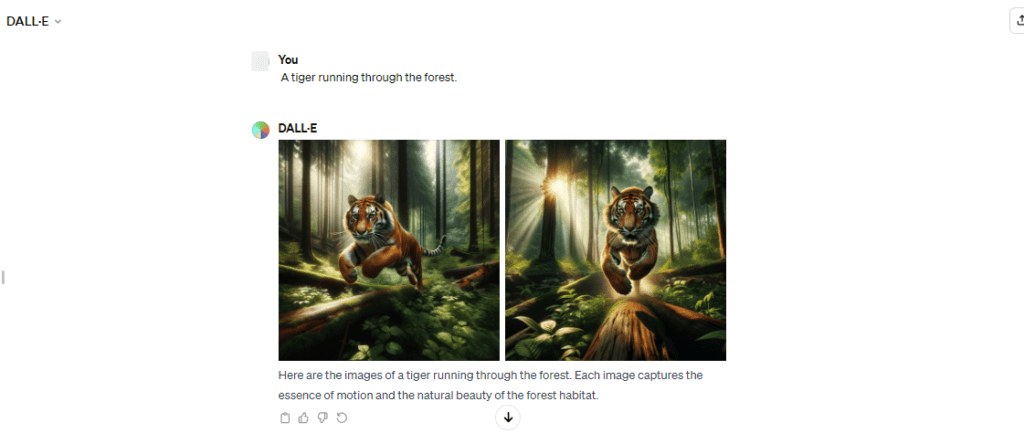

Midjourney is more complex to use from the beginning. Unlike others, it doesn’t offer a website to use its service. Instead, it would help if you went through Discord, an app for group chats, to use it. Although creating a Discord account and joining Midjourney’s server is simple, employing an AI art generator is unusual.
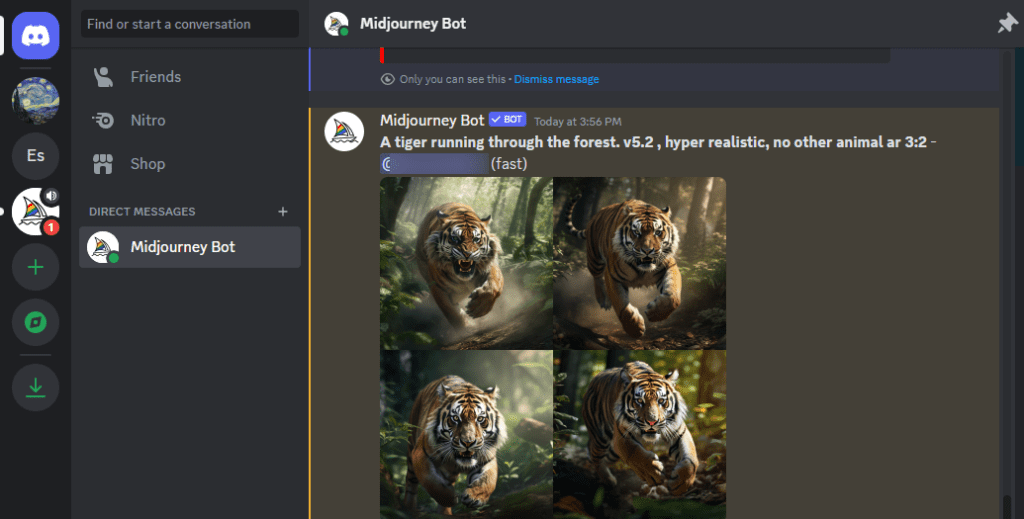

Takeaway: Therefore, if you want to try out an image generator, DALL·E 3 is much simpler and one of the finest image generation tools.
Midjourney is More Powerful
Despite its uneasiness, Midjourney offers a great deal. It’s likely the most robust AI tool for creating images, especially if you need more time to be ready to develop your custom model.
Firstly, regarding the settings, by entering — and then the appropriate command, you can adjust aspects such as the shape and size of your pictures, their diversity, the initial seed used, and even if you wish to generate continuous tiles for uniform patterns.


Following that, you can access tools to enhance and modify your pictures. After initiating a prompt, you are shown two groups of four buttons each: U1, U2, U3, and U4, which enlarge the respective image to a width of 1024px, and V1, V2, V3, and V4, which reprocess your prompt to generate additional variations related to the specific image.
Let’s go for U2.


After upscaling the desired image, you can further enlarge it to a width of 2048 pixels or even to 4096 pixels by clicking on the Upscale (2x) or Upscale (4x) buttons. You can generate variations that closely resemble the original image by selecting Vary (Subtle) or create variations that stand out more by choosing Vary (Strong). You can also modify particular picture sections by using Vary (Region).
Let’s try “Very subtle”


The Zoom Out and Pan buttons (marked with arrows) let you expand what you’ve made past its original limits. If you activate Remix mode, you gain additional power to alter your prompt whenever you introduce changes.
Let’s zoom out 2X here.


DALL·E 3 doesn’t match up to these features. You can change the picture’s shape a bit, but for everything else, you need to ask ChatGPT to try with a different request. Even the Bing tools with DALL·E 3 don’t offer much more. The standout features are Image Creator’s ability to pull your picture straight into Microsoft Designer and Paint’s feature to create images within the app, allowing you to modify them (or at least draw on them).
When you ask ChatGPT for changes, it makes new pictures based on a new request.
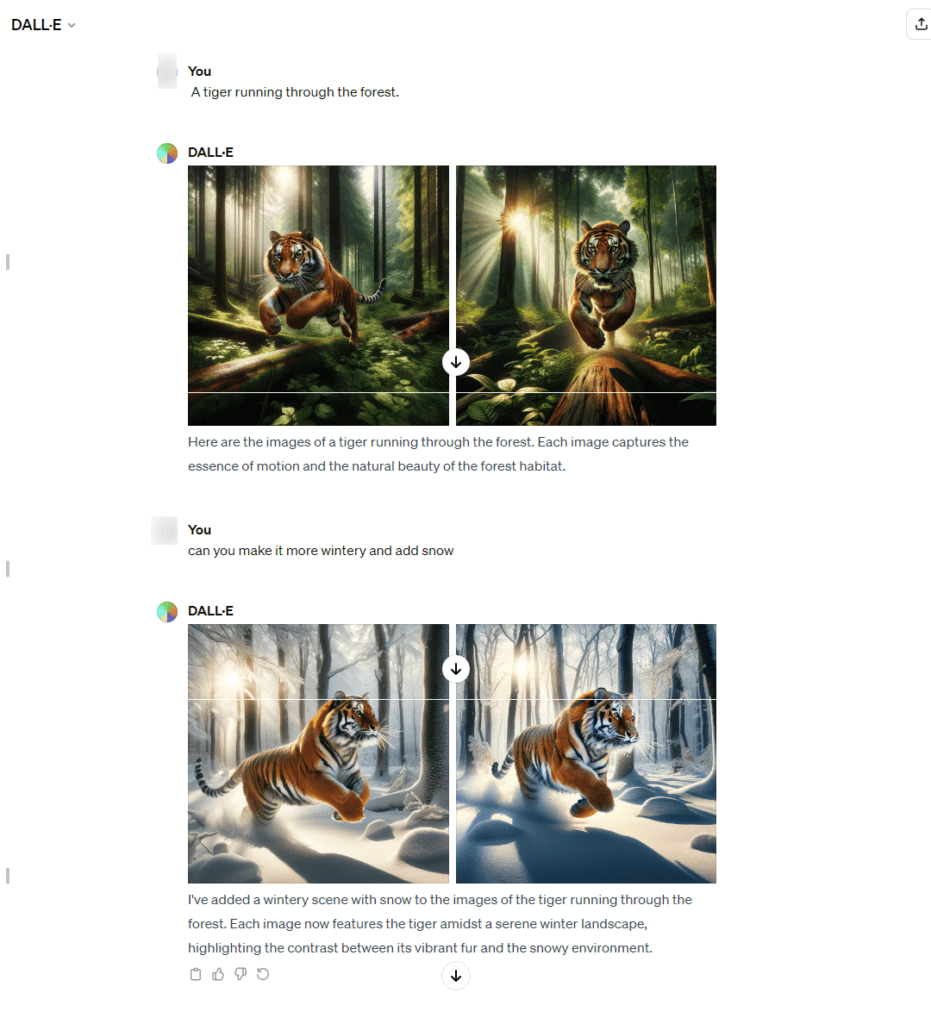

Surprisingly, for now, DALL·E 3 is getting closer to Midjourney in capabilities. It even lets you modify the inside parts of a picture (inpaint) and expand the image beyond its original edges (outpaint). The quality isn’t as high yet, but it gives you more freedom to make changes.
Both Make Great AI-Generated Images
Despite this, DALL·E 3 and Midjourney can produce excellent images. DALL·E 3 operates faster and is more straightforward, although it offers less control over the final images. Midjourney, on the other hand, can be somewhat tricky to understand at times, yet it allows for much greater control over the appearance of the images.
However, there are a few notable differences to mention. DALL·E 3, with its integration with ChatGPT, excels at understanding prompts. It seems to do a better job with both brief and longer and more complex prompts.
It does not mean that Midjourney frequently makes errors but requires more guidance. We discovered that rather than writing lengthy descriptions, providing it with a list of keywords was more effective.


Pricing Vary According to Needs
The price structure for DALL·E 3 is straightforward: it’s included in the ChatGPT Plus subscription for $20/month, or you can use it for no charge with various Microsoft tools, though some options might add a watermark to your creations.
There hasn’t been any official word on a cap for the number of images you can make each day or month with DALL·E 3, but such limits are likely in place to keep people from generating images endlessly.
On the other hand, Midjourney doesn’t offer a free version. Their Basic Plan begins at $10/month, giving you access to 200 minutes of GPU time. This aspect introduces some complexity. Midjourney estimates this equates to about 200 image generations per month, but the actual number can vary greatly depending on your usage.
Generating many variations or upgrading every image to the highest resolution will deplete your GPU time more quickly than producing a higher volume of lower-resolution photos.


To add complexity, you’re given additional fast GPU hours if you choose the Standard plan at $30 per month. Additionally, in Relax mode, which operates only when GPU resources are not used elsewhere, you can create as many images as you like.
Considering the vast array of benefits each application offers, we find it quite challenging to compare DALL·E 3 and Midjourney solely on their pricing. If you’re looking for a good mix of features at an affordable cost, the $10 per month Midjourney plan might be the ideal choice.
However, you can use DALL·E 3 at no cost through Bing Image Creator or for $20 per month as a part of the ChatGPT Plus subscription, which includes all of ChatGPT’s language capabilities.
Commercial Use is Complicated
When you think about using DALL·E 3 or Midjourney for making money or business purposes, the situation becomes a bit tricky. You can use both tools for business (except when accessing DALL·E 3 via Microsoft), but much about the law hasn’t been thoroughly looked into.
In February 2023, the U.S. Copyright Office decided that pictures made by Midjourney and other similar AI tools cannot have a copyright. This decision implies that your rights are limited if someone takes and uses your pictures without permission. Taking someone else’s picture is against Midjourney’s rules; relying on these rules might not offer much legal protection if you plan to use the platform for branding or creating unique characters. At most, Midjourney might ban the person who misuses your pictures.
Looking at it from a practical angle, Midjourney might be the better choice for monetizing your AI-generated art because it offers more flexibility. DALL·E 3, on the other hand, has strict restrictions and will prevent you from creating a wide variety of content, including images featuring celebrities.
Midjourney is Weird
In our effort to carefully and thoughtfully compare DALL·E 3 with Midjourney, we’ve encountered a few peculiar and challenging aspects of Midjourney that we’ve not yet discussed. Here are three crucial points to keep in mind:
If you don’t subscribe to the $60/month Pro plan and turn on Stealth Mode, Midjourney makes all your creations public in its member gallery. This means anyone can view, download, and use your image prompts.
Interacting with Midjourney involves using a series of commands with a Discord bot, which is always an unusual experience.
Midjourney offers a unique anime model, Niji, which you can access by appending –niji 5 to your prompt or selecting it via the /settings command.
The support documentation is excellent, and navigating Midjourney typically presents no significant problems. However, the experience can feel odd if you’re anticipating the familiarity of using a standard app. They are in the process of creating a conventional web app, and we are eagerly awaiting its release.
You Can Automate DALL·E Easily
DALL·E is linked to Zapier, so you can easily use it within your favorite apps. For instance, you can make pictures using chat messages, database info, forms, or spreadsheets and then send those images to any other app you like. Learn more about automating AI image creation with Zapier, or begin with ready-made workflows.
Midjourney vs Dall-e 3 Which One is Preferable?
- In the era of image generation, the comparison between DALL·E and Midjourney is a topic of significant interest. When evaluating these two AI-driven image generators, it becomes evident that the choice ultimately depends on your specific requirements and preferences.
- DALL·E 3 offers a user-friendly experience, making it the preferred choice for those seeking an uncomplicated image generation process. Its reliability and ability to consistently produce high-quality images make it a suitable option for users who prioritize ease of use.
- Midjourney, on the other hand, excels in providing users with the best AI image-generation capabilities available. It allows users to fine-tune and edit their images, albeit with a learning curve due to its quirks. For those who value customization and are willing to invest the effort, Midjourney is a compelling choice.
- Another contender in this arena is Stable Diffusion, which balances Midjourney’s power and DALL·E 3’s simplicity. It offers stability and enhanced image generation capabilities, making it a middle-ground option for users familiar with Discord’s image generation capabilities.
- When considering DALL·E 3 and Midjourney, it’s essential to analyze differences in terms of their use right. DALL·E 3 provides straightforward terms of use, while Midjourney may require users to navigate certain intricacies.
In conclusion, choosing between DALL·E 3, Midjourney, or Stable Diffusion depends on your priorities. If you seek a straightforward and reliable image generator, DALL·E 3 is a suitable choice.
However, if you desire fine-tuned control and are willing to invest the effort, Midjourney may be preferable. Stable Diffusion offers a middle-ground solution for those seeking enhanced capabilities without excessive complexity.


